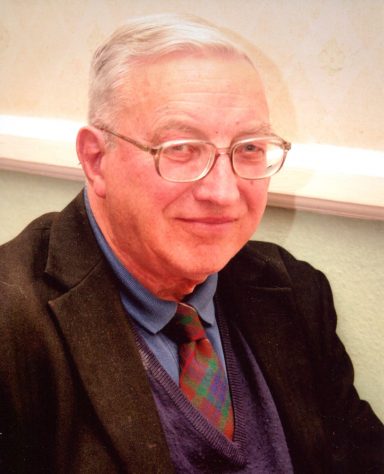
This appreciation has been compiled from Les’s albums and autobiographical notes, together with comments gathered from others who knew him over his long life.
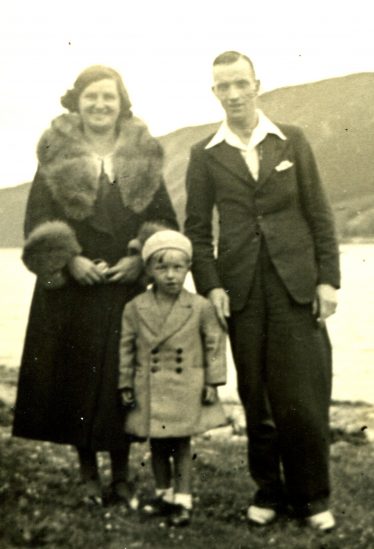
Eleanor, Leslie and Ernie Casey, beside Loch Ness

“Leslie apparently had an early interest in pebbles”
Les was born on 12 December 1930 in Inverness, where he lived with his parents Eleanor and Ernie Casey first at 20 May Court, and than at 56 Maxwell Drive, Inverness. A note in one of his many albums shows him on a beach, with the comment “My interest in rocks seems to have begun early”. He started school at Inverness Central School. His father was a civil servant, moving around the country, so in 1935 the family moved to London, first to Thorney Hedge Road in Gunnesbury, then in 1938 to 75 Fielding Road, Acton. From here he went to Belmont Infants School in Turnham Green.
Evacuee – and schooldays in Wales
At the outbreak of war the family were staying with relatives in Inverness, and also spent a week with Les’s maternal grandfather in Balintore on the Moray Firth where he attended a village school, and first came across school slates and slate-pencils used for practising writing.
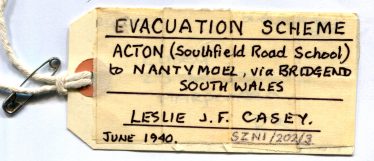
The family returned to their home in London early in 1940, but in June 1940 Les, with about 50 others from his school, was evacuated to Nantymoel in South Wales.
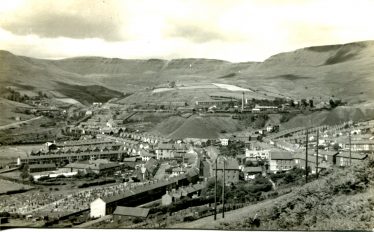
Postcard of Nantymoel
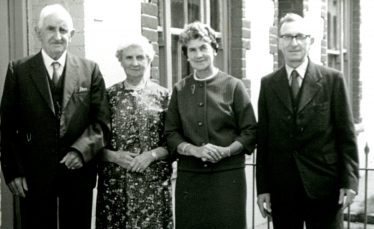
Ned and Dorothy Turner (foster-parents), Violet & Tom Hughes
From the reception centre at the school, he was collected by Tom Hughes and taken to be introduced to Dorothy and Ned Turner at 35 Oakfield Terrace, who were to be his foster-parents for the duration of the war and for some time afterwards – leading to Les acquiring a Welsh accent for life, and to a lifelong friendship. In writing his memories, he described his first meal of bread and butter, tinned pears with cream and home-made cake, commenting “You can rely on a 9 year-old boy to remember first what he had to eat”. His mother managed occasional visits, and later in the war he was able to travel to London for the school holidays – which was when he got to sleep sometimes in an Anderson shelter in the garden.

New boy at Ogmore Grammary School, c.1941/2
After passing the 11+ Les attended Ogmore Grammar School, and after the war he stayed with the Turners during term-time to continue at the Grammar School until 1950. Among his albums is a geography project completed in 1949 for his Higher School Certificate at Ogmore Grammar School, with exquisitely drawn maps and diagrams and his handwritten text (see sample at the foot of the page). In 1994 he loaned his file to Nantymoel Primary School and the headteacher wrote thanking him for “this superb historical document” – definitely a hint of things to come.
His mother had stayed in London, and was bombed out, being rehoused in a Council flat in Acton Vale in about 1948. We are not sure at what stage Les’s parents separated, but photos from the 1950s onwards seem to show just ‘Mam’ in London and on various holiday trips. He remained in contact with his father, until Ernie died of lung cancer in 1965.
Student
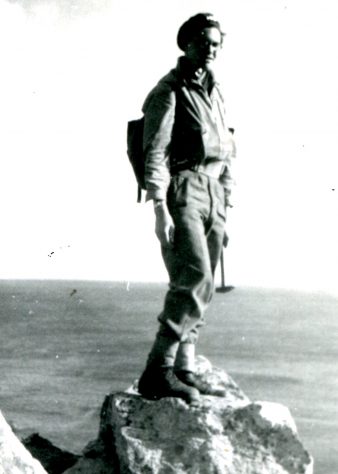
Geologist at the ready
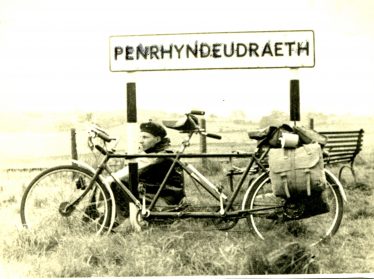
Tandem bike 1951 – just for its pack?
Les went on to study geology and geography at Bristol University, and photos show him on cycling and walking expeditions – including a tandem bike at Penrhyndeudraeth and with a geology hammer on a rocky shore.
National Service
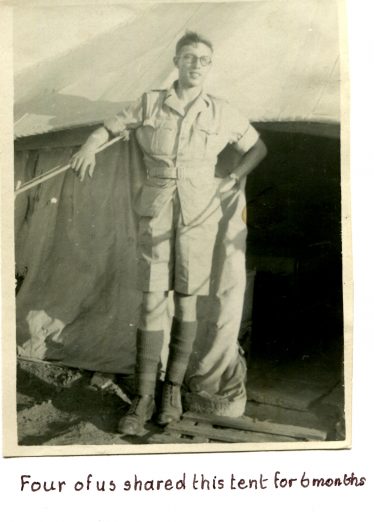
Camped in the Canal Zone
After graduating, Les was called up for National Service in October 1953, and assigned to the Royal Engineers. In preparation for a recent local history exhibition, he put together a file of his experiences, including training in field engineering: this included practical skills such as assembling and installing Bailey Bridges. Then a period at the School of Military Survey, where he learned cartographic draughtsmanship. He was posted to the Nile valley in Egypt and his account describes flying from Stansted, which was “little more than a control tower and a few Nissan huts” to Fayid in the Canal Zone.
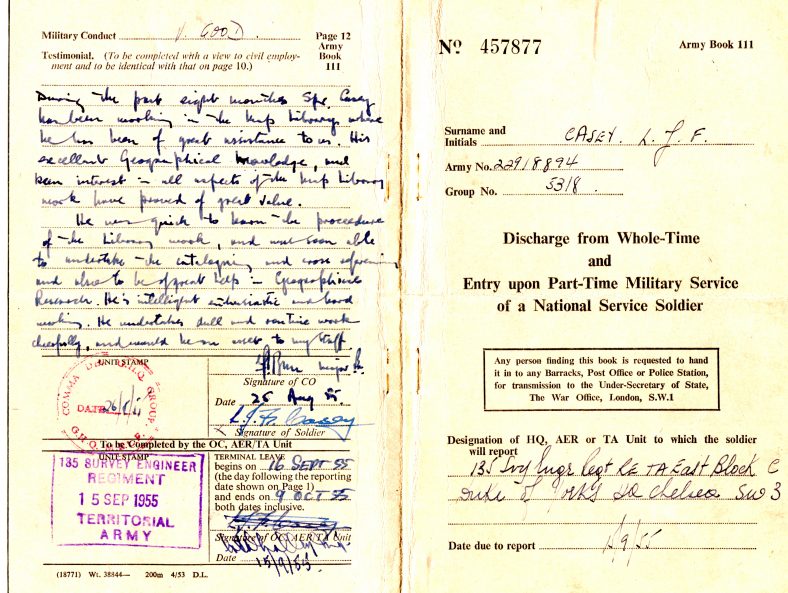
Testimonial in official discharge certificate
He was quickly spotted as someone suited to the Middle East Map Library. Here his job was to sort out the map chests and pick out out-dated maps, including old OS maps of Britain which were being stored there for safe keeping. Unwanted maps were to be incinerated, but some found their way home with him to London and “were useful during his later career as a teacher”. While in Egypt he had trips to Cairo, and along with fellow geologists from his Bristol university days, he explored the exposed rocks in the nearby desert, finding interesting fossils which he collected and sent home. Leave was spent in Cyprus, and the file contains fine photos of the Troodos mountains.
Teaching career
After National Service, Les trained as a teacher, and did his qualifying teaching year in Bristol and at Ogmore Grammar School where his former headmaster gave him a glowing reference, the last paragraph of which said “Three months of his teaching practice were done at the school and he came under my close observation during that period. He joined in the teaching and extra classroom activities of the school and he was popular with staff and pupils. His lessons were thoroughly prepared and he added considerably to the equipment of the school by producing many well-executed charts, maps and diagrams. He also provided many good geological specimens for the geology department”.
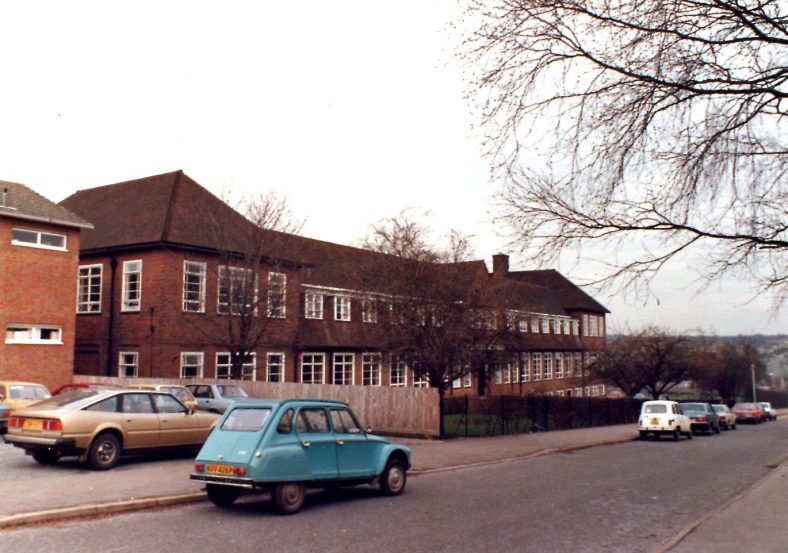
Manland Secondary School, 1980s
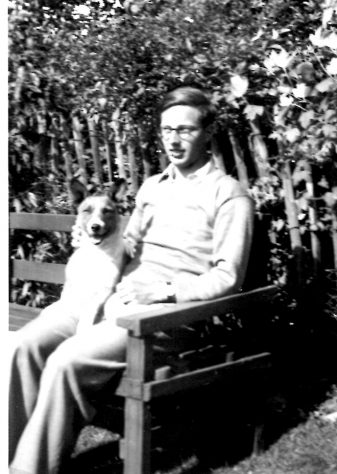
Relaxing in the garden?
His first full-time job, teaching geography and maths, was at Christopher Wren School in Kensington. When that school moved to larger premises, Les left and joined a small school in Letchworth where he spent three years at Pixmore School before moving to Harpenden and joining the staff at Manland Secondary School in the early 1960s.
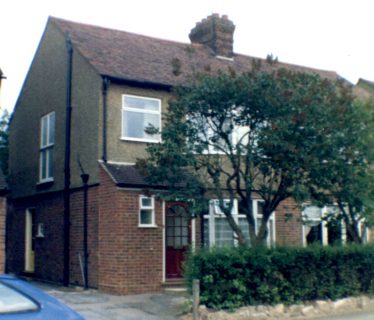
25 Overstone Road, 1970s
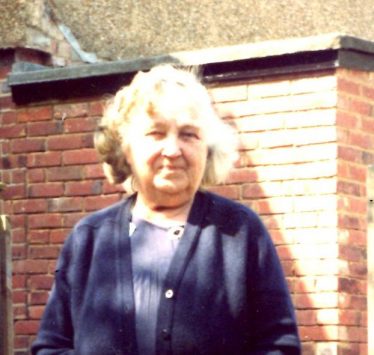
Eleanor Casey, 1970s
Settled for the rest of his life in Harpenden
With his mother he bought the house in Overstone Road, where they lived together until his mother’s death in 1986, and where Les lived until April this year when failing health meant he had to move to Willow Court, giving up his fierce independence.
Tributes
Colleagues and pupils have posted numerous comments on the Old Harpenden Facebook page, paying tribute to Les’s teaching, his enthusiasm for his subject and his interest and concern for his pupils – often recognising them years later in the High Street. Some mention the youth hostelling school trips in England and Norway – including his skill in making apple-pie beds. Long after official retirement Les continued as an assistant in the Art Department and only finally retired in 2000.
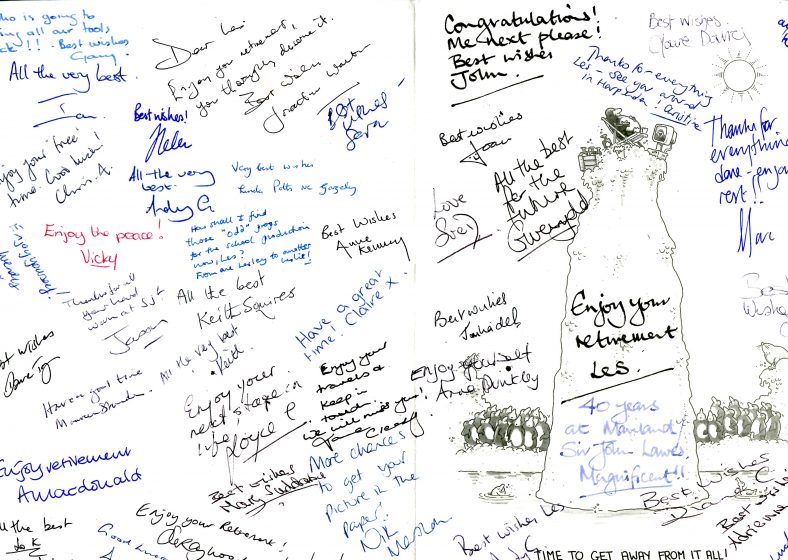
Retirement – after 40 years
Many and varied interests
Les’s hobbies and interest were wide and varied. Long cycle rides made him familiar with the local countryside, but also much further afield. He was a keen photographer, developing and printing photos for his own family albums, but also recording changes in Harpenden from when he first settled there. He was also a founder member and key activist in the Upper Lea Valley Group, helping with the heavy work involved in the transformation of the neglected Lea Valley into the lovely park and through walkway – now protected as Batford Springs Nature Reserve. He kept up his great interest in geology, attending meetings of the Hertfordshire Geological Society. He was a keen stamp collector, including carefully mounted first day issues and covers. And he collected money boxes and crested china – particularly gathering a large collection Goss and other designers of Harpenden and Hertfordshire crested items.
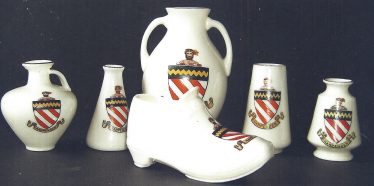
Examples of Harpenden Goss crested china
He wrote about collecting under the title “Why do people collect thing? Few collectors when asked can explain why they collect except that they enjoy doing so. There is pleasure in searching and finding articles of your chosen interest; exchanging or bargaining; sorting, classifying items; arranging and displaying them. There are memories of places visited and people met, with whom an interest has been shared.”
He was a regular visitor to the Brambleton Model Railway exhibitions and had albums full of photos of branch lines through Britain, gathered on his travels. He made the fullest possible use of his bus pass, both for extended holidays and trips into Wales, where he kept in touch with his foster family in their South Wales mining village and with cousins in North Wales. Most weeks he took a complicated route by bus from Harpenden, carefully using the bus timetables, and only occasionally getting stranded for a night. At home he quietly relaxed watching videos, of which he had a large library, and he was a keen reader.
Contribution to local history
But for many of us, his most important interest lay in local history. He joined the Local History Society as it was formed in 1973 and joined a small group who met weekly in the local history centre in the cottage at the rear of Harpenden Hall, sorting through the collections that had been assembled by the old Urban District Council for a future museum for Harpenden. He took over the compiling of the accessions register, and became familiar with the many artefacts in the Society’s collection. With his special interest in photographs, he took on the indexing of the thousands of photos, including many copied by Eric Meadows in the 1980s.
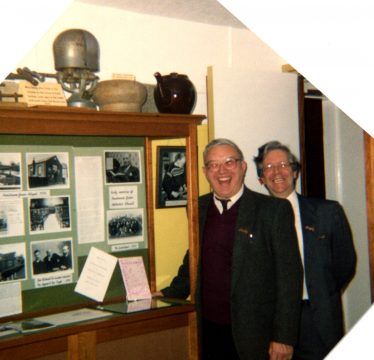
Les with Eric Brandreth in the local history centre
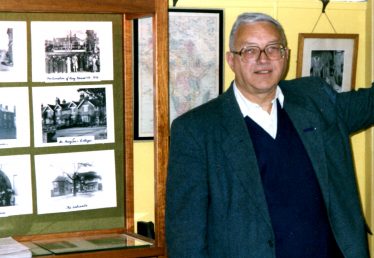
Les at one of his exhibitions in the local history centre
Harpenden’s short-lived museum
The highlight of Les’s work along with the group of active members was the museum accreditation for the collection, and the move into the Portacabin behind Harpenden Hall in 2000 – a small museum and archive centre for Harpenden. With the loss of that in 2003, the collection was dispersed, much of it to Les’s house and loft, until part of it could be brought to the history room in Park Hall.
Les was the last man standing of the Wednesday evening group, which had included Geoff Woodward and the Harpenden librarian Eric Brandreth. After Eric’s death in 2011, Les worked through countless boxes and files of Eric’s photos and information which are still gradually being absorbed into the files at the history centre.
Les mounted the quarterly exhibitions in Park Hall single-handedly over many years, using his imagination to find ways of using the huge collection of photos. He spent many hours in the local history centre and at home, working tirelessly for the Society. During many conversations over recent months, Les kept up his keen interest in the future and the growing hope that Harpenden may have a small museum in the planned new Cultural Centre.
His contribution has been immense and his deep commitment will be greatly missed, as will his quiet sense of humour. On his 85th birthday, he was looking forward with strong hopes of reaching 100. Sadly that was not to be.
His legacy
Towards the end of his life, Les indicated that he would like his house to become Harpenden’s much needed museum – and he translated this idea in his will by bequeathing his house to the Local History Society. From that bequest the Society has been able to negotiate a lease for rooms in the Eric Morecambe Centre in which to open Harpenden Museum. The archives he curated for so many years will be newly stored in the Les Casey Room.

Comments about this page
What a fascinating insight into the life of Mr Casey. He certainly had a life rich with so many interests. I, like so many others that went to Manland school in the 60s, met him when he was my geography teacher. Even up to recent years, when seeing him in the village he would still remember my name.
Sorry to hear that Les Casey has passed away. He was a good teacher and a major asset to Harpenden. May he rest in peace.
Add a comment about this page